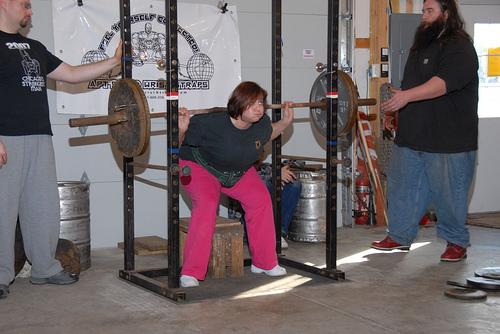Any true repetition maximum (RM) is a perturbation to the neuromuscular system, not just the 1RM. So if the system is being tested, experiencing novel movement challenges, especially maximal ones, by default, exercise technique won’t be perfect. Depending how far away you are from a 1RM, joint kinematics can flicker in and out of “ideal” because the nervous system is trying to stabilize the new movement strategy.
Thus, here we arrive at the age old question – how much “bad” technique, if any, should we allow during an RM test? Ask coaches and scientists and you’ll get different answers under a variety of different contexts. Could the proverbial “it depends” answer or “the truth is in the middle” theory be what we’re looking for?

There seems to be more important factors to address here than maximal strength testing
My own opinion changes a little depending on if men’s or women’s teams/athletes are the reference point. As the stereotype goes, most of the female athletes I work with at the NCAA D3 level need more encouragement to lift heavier weights than the men’s teams I work with. I find myself telling the guy’s to lower the weight and the girls to increase the weight. When we test a RM, the same holds true. If I get the female athlete to push herself beyond her comfort zone without the fear of “getting big and bulky” and her technique breaks slightly, I don’t worry about it. To me, the emotional benefit for this demographic outweighs the risk. Conversely, with the men’s teams, I find myself trying to create “emotional maturity” during a RM tests. Getting them to appreciate that a free weight exercise 1RM is just one of many variables in their sporting success. I also preach that we lift weights all the time so they’ll have a plethora of chances to succeed. Testing day is not the only day to push yourself beyond your limits.
I like to think of this whole process of shifting the athlete’s mindsets away from what is natural as one of the many pieces that make up “weightroom culture”. Getting girls to be uninhibited by aesthetic exercise implications and guys to exercise with a “controlled rage” is part of the sociology we as coaches deal with and enjoy. The driver is a huge part of what we do. Let it also be said the stereotypes I mention here are obviously not absolute. You’ll always have some who go against the grain.
All told each coach will draw the line between acceptable and unacceptable RM technique abstractly as I have yet to see a definition that fits all individuals and contexts. Here is an example of one of my athletes from last off-season:
I consider this excellent relative to a group setting. It goes without saying that not every single one of my athletes looks like this during their 1RM however I deem it a fair “ideal” when trying to do damage control in my group of 64 males at once. So in conclusion with respect to this part of a weightroom culture, I’m not sure there is a definition of “ideal” kinematics in a 1RM attempt. However I don’t think there needs to be either. Changing the mindset of our athletes and training the driver may just fix many of the associated “issues” with RM’s. Lastly, appreciate that a neural perturbation (RM) by default will not have perfect technique.
Nicely put Sam – I'd also add that testing need not happen every 4-6 weeks!!! We report our numbers 1-2x's year, and that helps us keep our training realistic, safe and HEALTHY. In the past 5 years, one thing that I've seen reaffirmed over and over again, is that the more often you bump their training max up, the less they improve into their veteran years. I actually very often set their training maxes at 90%-ish while hammering technique in the cycles after testing. I've found this to consistently lead to more on-going gains across the board on future test days, including those in the 5th year. That "buffer" has been really instrumental in keeping our guys feeling fresh while letting them really go for it on test day, not to mention the fact that working with the more manageable loads is constantly ingraining better technique altogether. I think its similar to what Boyle says about the 40 yd dash and the burn out that comes from repetitive exposure to it (we only test the 40 once/year as well.).
Nice piece.
Sam,
Interesting you posted this today. As I was training this morning, I was thinking a lot about the tolerance for deviation from "ideal" during 1RM testing. Glad to see your insight.
-Carson Boddicker
Well said, Donnell.
Thanks, Carson.